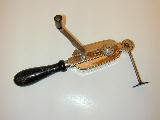history of corsets
Ancient Corsets
Traditional garb for some 15th Century virgins was a tightly bound dress, evocative of a corset.
Iron Corsets
Several museums today have examples of iron corsets. Some historians claim these to be everyday wear for European women and girls throughout the sixtee nth and seventeenth centuries, but such a garment or device would have been costly and beyond the pocket of everyday women. Such a corset would more likely to have been an orthopaedic tool to correct posture or obesity.
nth and seventeenth centuries, but such a garment or device would have been costly and beyond the pocket of everyday women. Such a corset would more likely to have been an orthopaedic tool to correct posture or obesity.
Assassination was a real threat in those days, and an iron corset as armour provided protection from bullet and knife. Favored initially by men, the iron corset went on to be worn by both women and men on court or dress occasions. Both corset and the dress of the time were very heavy, and considerable padding had to be worn underneath, the whole lot being decoratively covered with silk. Silk was a an expensive luxury, which indicates again the status of the corset then.
Only when worn by women was the garment referred to as a corset, it being called a waist coat or vest when sported by men.
Corsets with Stays 1550 – 1890
Stays were worn externally laced over the clothing (dress or skirt), unlike more conventional corsets which extended over the hips. Stays of the time were hand crafted from whale bone ( baleen ) and were popular around 1860. Eventually, stays became shorter, and evolved into a type of brassiere, with shoulder straps.
were worn externally laced over the clothing (dress or skirt), unlike more conventional corsets which extended over the hips. Stays of the time were hand crafted from whale bone ( baleen ) and were popular around 1860. Eventually, stays became shorter, and evolved into a type of brassiere, with shoulder straps.
Victorian era corsets, 1831 – 1901
When most people imagine a corset, they are most likely to think of a corset from Victor ian times. The Victorian era lasted some seventy years, during which time the corset underwent many changes of style and fashion as it evolved. One notable style was the ‘horizontal waist’, popular from 1850 to 1899. This complemented the fashionable ‘bustle’ of the day.
ian times. The Victorian era lasted some seventy years, during which time the corset underwent many changes of style and fashion as it evolved. One notable style was the ‘horizontal waist’, popular from 1850 to 1899. This complemented the fashionable ‘bustle’ of the day.
by: Davina Vincentes
Corset – like ‘idols’ have been discovered on the Greek island of Crete that date back to around 2000 B.C. By placing two ceramic pots together by their bases, a waist shape was obtained, with the handle of the upper pot representing the nose. The hour – glass shape was a traditional primitive Cretan style, and not necessarily representative of the local women. Earlier icons were decorated with loincloths, with later examples wearing a loincloth and open lace tunic.
Traditional garb for some 15th Century virgins was a tightly bound dress, evocative of a corset.
Iron Corsets
Several museums today have examples of iron corsets. Some historians claim these to be everyday wear for European women and girls throughout the sixtee
 nth and seventeenth centuries, but such a garment or device would have been costly and beyond the pocket of everyday women. Such a corset would more likely to have been an orthopaedic tool to correct posture or obesity.
nth and seventeenth centuries, but such a garment or device would have been costly and beyond the pocket of everyday women. Such a corset would more likely to have been an orthopaedic tool to correct posture or obesity.Assassination was a real threat in those days, and an iron corset as armour provided protection from bullet and knife. Favored initially by men, the iron corset went on to be worn by both women and men on court or dress occasions. Both corset and the dress of the time were very heavy, and considerable padding had to be worn underneath, the whole lot being decoratively covered with silk. Silk was a an expensive luxury, which indicates again the status of the corset then.
Only when worn by women was the garment referred to as a corset, it being called a waist coat or vest when sported by men.
Corsets with Stays 1550 – 1890
Stays
 were worn externally laced over the clothing (dress or skirt), unlike more conventional corsets which extended over the hips. Stays of the time were hand crafted from whale bone ( baleen ) and were popular around 1860. Eventually, stays became shorter, and evolved into a type of brassiere, with shoulder straps.
were worn externally laced over the clothing (dress or skirt), unlike more conventional corsets which extended over the hips. Stays of the time were hand crafted from whale bone ( baleen ) and were popular around 1860. Eventually, stays became shorter, and evolved into a type of brassiere, with shoulder straps.Victorian era corsets, 1831 – 1901
When most people imagine a corset, they are most likely to think of a corset from Victor
 ian times. The Victorian era lasted some seventy years, during which time the corset underwent many changes of style and fashion as it evolved. One notable style was the ‘horizontal waist’, popular from 1850 to 1899. This complemented the fashionable ‘bustle’ of the day.
ian times. The Victorian era lasted some seventy years, during which time the corset underwent many changes of style and fashion as it evolved. One notable style was the ‘horizontal waist’, popular from 1850 to 1899. This complemented the fashionable ‘bustle’ of the day.by: Davina Vincentes
















